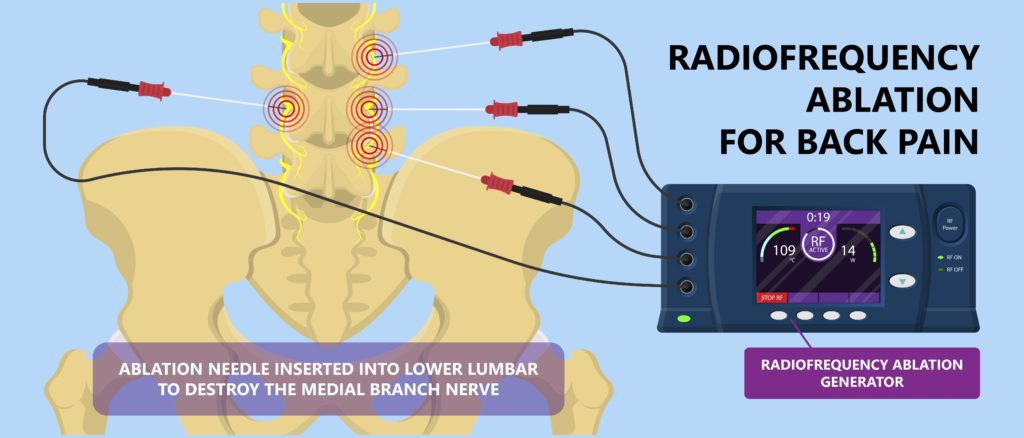Facet joints in the neck and back can cause debilitating pain. Radiofrequency Ablation (or Neurotomy) numbs this pain by safely cauterizing the small medial branch nerves that provide sensation to the facet joints. Patients that have been shown to have pain originating from the facet joints along the spine are candidates for this procedure. Injections to block the facet joints and the median branch nerves that innervate the joints are performed prior to the cauterization procedure itself, so the overall process involves several visits. The pain reduction will typically last 6-24 months until the nerve branches are able to repair, and the RFA procedure can be repeated when the pain returns.
How Do Spinal Facet Joints Cause Pain?
There are several potential pain generators in the spine. These can include the joints, nerves and the shock-absorbing discs that separate the bones. Pain coming from the joints (facet joints) can be an achy discomfort on one, or both sides of the neck or back. This can radiate to the shoulders or buttocks. This can be worse with turning the head or twisting the low back along with discomfort in the morning and with standing, walking and bending backwards.

Once the facet joints are determined to be the primary pain generator, we can start to explore different treatment options. Facet mediated pain can be addressed with several treatment options including rehabilitation, steroid injections, regenerative medicine (Platelet Rich Plasma PRP and BMAC Stem Cell Therapy) as well as a treatment called radiofrequency ablation (RFA).
What Are Median Branch Nerves?
Median branch nerves are small nerves that branch out from larger spinal nerves exiting the spine. The nerves supply the facet joints, ligaments, skin, and small muscles at each segment. These are not the nerves that are responsible for the movement of the extremities and sensation in the
arms or legs. For each facet joint, 2 different nerve branches must be treated to stop the facet joint pain.
Are the Facet Joints Causing Your Pain? Let’s See.
To determine if you’re a good candidate for radiofrequency neurotomy, you will start with a good history and physical exam along with possible imaging such as an MRI. Then, a test (Medial Branch Block) is done that blocks the nerves to the facet joints. This will help determine if the nerves commonly targeted by the procedure are the same nerves responsible for your pain. During the test blocks, a small amount of numbing medication is injected into the precise spots where the radiofrequency needles will go. If your pain significantly lessens, radiofrequency treatment at those spots may help you.
Patients that have been shown to have pain originating from the facet joints are candidates for the Radiofrequency Ablation procedure.
What is Radiofrequency Ablation?
The radiofrequency ablation, or neurotomy, is a way to disrupt the nerve signals from the joint to the spinal cord. This treatment uses heat generated by radio waves to turn off the nerve’s ability to send pain signals.
Radiofrequency Ablation involves the cauterization of small nerve branches to eliminate certain types of spinal pain. There are many causes of spine pain, and this procedure addresses the facet joints predominantly. Other sources of pain, such as nerve compression and disk pain, are not affected. The procedure produces a small heat lesion to either destroy or deactivate the nerve, while leaving the surrounding region and larger nerves unaffected.
Needles are inserted through the skin and guided to the target nerves under a live X-ray machine called a fluoroscope. The needles are then connected to a machine that generates the radio waves that are transmitted to the tip of the needle which is next to the target nerve.

RFA is an outpatient procedure. Patients are positioned on the stomach and the area is cleaned and draped. The skin is numbed before the radiofrequency needles are inserted. Once the needles are properly positioned and the ablation has started, the patient may feel warmth or pressure at the area. This is usually tolerated pretty well, but if it is too uncomfortable, the physician may reposition the needles or add extra numbing medicine. The procedure typically takes less than an hour and the patient is then monitored in the recovery area for about 30 minutes.
Is Radiofrequency Ablation Effective?
This has been shown to be a very safe and effective procedure (https://academic.oup.com/painmedicine/article/21/5/902/5586928?login=true) that has been employed since the 1950s. Like with any medical procedure, there are inherent risks. These commonly include temporary numbness or soreness around the injection sites. Rarely, more-serious complications may occur, including bleeding, infection or nerve damage. These risks are minimized by partnering with a physician who is able to formulate a good diagnosis and is proficient at the procedure.
Overall, 75-80% of patients report satisfaction with the procedure. The nerves will generally grow back over the first year. Patients may require a repeat procedure as soon as 6 months but often the pain relief lasts for 1-2 years. Current evidence generated over many years does not
demonstrate any significant long-term acceleration of degeneration nor significant nerve problems, and it is believed that the benefits substantially outweigh the known and theoretical risks.
There may be no clear benefit from the procedure for 3-6 weeks, although most patients begin to experience some relief in the first 2-3 weeks. Many patients benefit for 9-18 months, and some have found marked improvement for over two years. The procedure will likely need to be repeated when the beneficial effects have worn off. Current research indicates that repeat procedures are as effective as the initial procedure.
Radiofrequency ablation isn’t a permanent fix for back or neck pain, but we have found this to be a very useful tool to address neck and back pain stemming from the facet joints.

Board-Certified Physical Medicine & Rehabilitation by ABPMR and AOBPMR
Fellowship-Trained and Board-Certified in Pain and Musculoskeletal Medicine




